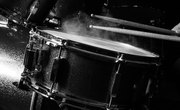
Sir Isaac Newton's second law of motion states that the force exerted by a moving object is equal to its mass times its acceleration in the direction from which it is pushed, stated as the formula F=ma. Because force is proportional to mass and acceleration, doubling either the mass or acceleration while leaving the other constant will double the force of impact; the force of impact increases when an object of constant weight is subject to greater acceleration. You can explore several different experiments that demonstrate this principle.
Crater Experiment
Collect a rock and a wadded up piece of paper. Because gravity's acceleration is constant, all objects fall at the same rate regardless of their mass. Test this law by dropping both items simultaneously and watching them fall at the same speed. Now place a bowl filled with powdered sugar or flour underneath the rock, and drop it from a fixed height into the powder. Set the bowl to the side, being careful not to disturb the powder in it. Drop the ball of paper from the same height into a bowl with the same amount of the same powder. Compare the craters in the powder created by each impact. Because acceleration was constant, the difference in size between the crater made by the rock and the one made by the paper illustrates that an increase in mass directly increases the force of the impact into the flour.
Softball Experiment
Screw an eyelet into a softball and another into the lintel of a door frame. Hang the softball from the door frame by a piece of string tied through the eyelets so that it hangs a few centimeters above the floor. Mark the spot directly underneath the softball's resting position. Move the hanging softball and place another softball on the marked spot. Pull the hanging softball back so it is three feet from the ground and release it so it swings and hits the softball on the floor. Measure the distance the softball on the floor travels. Repeat the experiment, substituting a plastic Wiffle ball for the softball on the floor, and measure how far it rolls after impact. This experiment illustrates that when force is held constant, the acceleration is greater in objects with less mass.
Hot Wheels Experiment
Construct a simple ramp 18 inches high and about 24 inches long using a piece of thin plywood and bricks. Place a toy car at the top of the ramp. Release it and measure how far it rolls. Tape two metal washers to the car, release it from the ramp and measure how far it rolls. Repeat the experiment with five washers taped to the top of the car. This experiment shows that as mass increases with gravity's constant acceleration, the force pushing the car along the floor increases, making heavier cars travel farther.
Wagon and String
Obtain a child's wagon, some light cotton string or thread, and two or three small volunteers. Tie the string around the wagon handle and leave 2 or 3 feet of string hanging off the handle to pull with. Begin with an empty wagon. On flat, level ground such as a sidewalk, and from a standing start, pull the string until you reach a comfortable walking speed. Note the effort it takes to pull the wagon. Next, have one of your volunteers sit in the wagon and once again pull the string until you reach walking speed. Note the effort needed to pull the wagon. The string can take only a small amount of force before it breaks; the more riders in your wagon, the more force you need to pull it, until you pass the string's breaking point. With this experiment, your acceleration is about the same each time, though you need to pull with more force due to the additional mass of each new passenger. How many passengers can you pull before the string breaks?
References
About the Author
Wilhelm Schnotz has worked as a freelance writer since 1998, covering arts and entertainment, culture and financial stories for a variety of consumer publications. His work has appeared in dozens of print titles, including "TV Guide" and "The Dallas Observer." Schnotz holds a Bachelor of Arts in journalism from Colorado State University.
